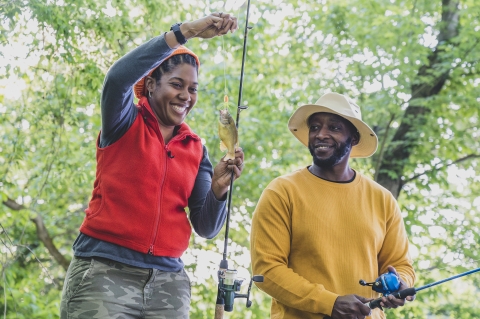Released last year, the 2022 National Survey of Fishing, Hunting, and Wildlife-Associated Recreation indicates that hunting and fishing remain highly important outdoor pursuits in the United States. In 2022, there were 14.4 million hunters and 39.9 million anglers aged 16 years and older across the country. These activities enable participants to feed their families and communities and offer a way to connect with nature and create lifelong memories. However, there are a number of indications that participation in fishing and hunting has been declining over the years. To address this decline Recruitment, Retention, and Reactivation, also known as R3, efforts have been implemented across the nation to increase hunting and fishing access and participation.
U.S. Fish and Wildlife Service economists recently released an in-depth addendum report that dives into fishing and hunting recruitment, retention, and reactivation data collected through 2022 National Survey responses. The Recruitment, Retention, and Reactivation of Hunter and Anglers in the U.S. addendum report provides a new suite of information on R3 efforts and examines R3 metrics across numerous characteristics such as age, race, and income. “Understanding demographics and associated behaviors can inform current and future R3 efforts undertaken by the Service and our partners,” said Tom Decker, Branch Manager for Communication, Analysis, and Partnerships with the Service’s Office of Conservation Investment. “These report insights can be used by state fish and wildlife agencies, industry, and non-profit organizations working to welcome new community members and retain current participants involved in outdoor pursuits.”
One such partner is the Council to Advance Hunting and the Shooting Sports. CAHSS facilitates the promotion and growth of hunting and the shooting sports and serves as a hub of information connecting R3 practitioners and provides case studies, toolkits, and a practitioner’s guide to aid and connect those working to advance hunting and the shooting sports. “The release of the R3 addendum report is a critical resource for the R3 community. Updated data provides us with the insights needed to effectively evaluate and enhance our recruitment, retention, and reactivation efforts across the country,” said CAHSS Executive Director Dr. Steven Leath. “These efforts are crucial for the future of shooting sports and conservation, as they help ensure that we continue to foster a strong, engaged community dedicated to protecting our outdoor traditions and wild places.”
In-depth R3 data sections in the new addendum report include data on the age of introduction to fishing and hunting, demographic and associated behaviors of all and first-time fishing and hunting participants, a section on the demographic and associated behaviors of adult first-time participants, and more. Report findings affirm the importance of youth engagement for anglers and hunters with adolescence still being the most important period for introduction into these outdoor pursuits. However, the addendum highlights that adult introduction is also important for recruitment and punctuates that other opportunities exist to recruit more anglers and hunters in young adult and middle-aged demographics. This type of data can aid R3 coordinators and the larger R3 community when designing outreach materials, courses, and workshops.
Other sections indicate that females are more prevalent among new entrants to hunting and fishing than among the populations of all active hunters and anglers. While females comprise 17 percent of all active hunters, they represent 33 percent of entrants. For fishing, females represent 37 percent of entrants and 30 percent of overall anglers. “This could suggest that of late, females are initiated into hunting and fishing more than they have been historically. Alternatively, it could suggest that women are more likely to give up the pursuits after they have entered the community,” said Jerry Leonard, Economist with the Office of Conservation Investment. While the addendum report represents a snapshot of R3 data from the 2022 National Survey, addendum report findings are often utilized by partner organizations and researchers to inform further research into participation trends.
The Service has conducted the National Survey roughly every five years since 1955. In the 1980s, addendum reports were created allowing for in-depth analysis of the larger National Survey data sets providing information on recent and long-term trends on a variety of topics. The wealth of information presented in each survey and addendum allows stakeholders, researchers, and agency partners to view current participation data and provide a historic perspective of participation in fishing, hunting, and wildlife watching. Every survey and addendum contains an updated snapshot of outdoor pursuits that can aid with efforts to increase access to these activities while also highlighting opportunities for further engagement and research. Past National Survey and addendum reports can be accessed at https://www.fws.gov/program/national-survey-fishing-hunting-and-wildlife-associated-recreation-fhwar.





